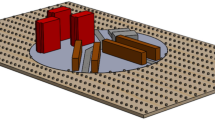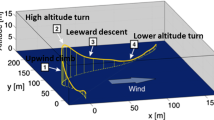Abstract
As unmanned aerial vehicles are expected to do more and more advanced tasks, improved range and persistence is required. This paper presents a method of using shallow layer cumulus convection to extend the range and duration of small unmanned aerial vehicles. A simulation model of an X-models XCalubur electric motor-glider is used in combination with a refined 4D parametric thermal model to simulate soaring flight. The parametric thermal model builds on previous successful models with refinements to more accurately describe the weather in northern Europe. The implementation of the variation of the MacCready setting is discussed. Methods for generating efficient trajectories are evaluated and recommendations are made regarding implementation.
Similar content being viewed by others
References
J. Wharington, I. Herszberg. Control of a high endurance unmanned air vehicle. In Proceedings of the 21st ICAS Congress, Melbourne, Australia, ICAS-98-3,7,1, AIAA A98-31555, 1998.
M. J. Allen. Autonomous soaring for improved endurance of a small uninhabited air vehicle. In Proceedings of AIAA Aerospace Sciences Meeting and Exhibit, NASA Dryden Flight Research Center, Reno, NV, 2005.
D. J. Edwards. Implementation details and flight test results of an autonomous soaring controller. In Proceedings of AIAA Guidance, Navigation, and Control Conference, AIAA, Honolulu, Hawaii, pp. 10–13, 2008.
F. Irving. The Paths of Soaring Flight, London, UK: Imperial College Press, 2006.
M. J. Allen. Updraft model for development of autonomous soaring uninhabited air vehicles. In Proceedings of AIAA Aerospace Sciences Meeting and Exhibit, Reno, Nevada, 2006.
J. A. Kyle. Optimal Soaring by a Small Autonomous Glider, Ph.D. dissertation, Oregon State University, USA, 2007.
D. Piggott. Gliding, A Handbook on Soaring Flight, London, UK: A & C Black, 2002.
C. E. Wallington. Meteorology for Glider Pilots, 3rd ed., Albuquerque, New Mexico: Transatlantic Arts, 1980.
A. Welch. Pilots’ Whether, London, UK: William Clowes & Sons, 1973.
J. Delafield. Gliding Competitively, London, UK: A & C Black Publishers Ltd, 1982.
D. H. Lenschow, P. L. Stephens. The role of thermals in the convective boundary layer. Boundary-layer Meteorology, vol. 19, no. 4, pp. 509–532, 1980.
P. B. MacCready. Optimum airspeed selector. Soaring, vol. 18, no. 2, pp. 16–21, 1954.
J. H. Cochrane. MacCready theory with uncertain lift and limited altitude. Technical Soaring, vol. 23, no. 3, pp. 88–96, 1999.
I. D. Cowling, S. Willcox, Y. Patel, P. Smith, M. Roberts. Increasing persistence of UAVs and MAVs through thermal soaring. The Aeronautical Journal, vol. 113, no. 1145, pp. 479–489, 2009.
Author information
Authors and Affiliations
Corresponding author
Additional information
J. H. A. Clarke received his M.Eng. degree in aeronautical engineering from the Department of Aeronautical and Automotive Engineering at Loughborough University, UK in 2008. He is currently a Ph.D. researcher in the same department. His masters degree specialised in stabilisation and control of autonomous helicopters.
His research interests include activities include advanced attitude and heading determination and energy efficient trajectory generation for autonomous vehicles. As an experienced full size and scale pilot, he has managed the laboratory’s unmanned aerial vehicle operations for the last 3 years.
Wen-Hua Chen received his M. Sc. and Ph.D. degrees from Department of Automatic Control at Northeast University, PRC in 1989 and 1991, respectively. From 1991 to 1996, he was a lecturer in Department of Automatic Control at Nanjing University of Aeronautics and Astronautics, PRC. He held a research position and then a lectureship in control engineering in Centre for Systems and Control at University of Glasgow, UK from 1997 to 2000. He currently holds a senior lectureship in flight control systems in Department of Aeronautical and Automotive Engineering at Loughborough University, UK. He has published three books and more than 150 articles in journals and conferences.
His research interests include the development of advanced control strategies and their applications in aerospace engineering, in particular in unmanned aircraft systems.
Rights and permissions
About this article
Cite this article
Clarke, J.H.A., Chen, WH. Trajectory generation for autonomous soaring UAS. Int. J. Autom. Comput. 9, 248–256 (2012). https://doi.org/10.1007/s11633-012-0641-5
Received:
Revised:
Published:
Issue Date:
DOI: https://doi.org/10.1007/s11633-012-0641-5




